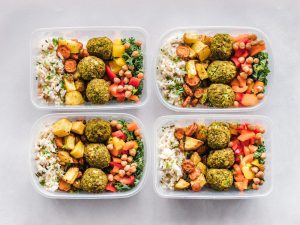Have you ever spent too much time trying to convince yourself to cook dinner, just to end up throwing in the towel and ordering takeout? You’re not alone. After a long day, the idea of gathering ingredients, finding a recipe, and preparing a meal can be unbearable. Companies that offer meal box subscription kits know this, and have seen an opportunity to market to young professionals and busy families with their easy, pre-assembled kits. Just cook and eat! Healthy, cost-effective meals for busy people, they say, but are they really cost effective or healthy?
The Facts
There are many meal subscription boxes on the market now, and all have their pros and cons. Here are four of the most popular brands, and a little more about them:
1. Blue Apron: The classic meal subscription box.
- Pros: The recipes are high-quality, like what you would find on the menu of a nice restaurant. The price, starting at $9.99 per serving for three meals for two, is acceptable.
- Cons: They may help reduce food waste, but each ingredient is individually packed, resulting in a lot of trash and recyclables.
2. HelloFresh: They claim to be America’s most popular meal kit.
- Pros: These meals truly are quick and most of them are easy, though you can choose from 20 recipes a week and can pick something more challenging. Meals are hearty and can sometimes result in leftovers. The cost, $8.99 per serving for two people, three times a week, is the lowest of the four.
- Cons: Ingredients are not locally sourced, so you might end up with shrimp from India or produce that didn’t survive the delivery.

Purple Carrot meal boxes are time consuming and cost more for a plate per person than making your own meal.
3. Purple Carrot: A vegan-only option.
- Pros: Great option for vegans or the vegan-curious. A good blend of classic and exciting recipes.
- Cons: You don’t get to choose your recipes. All are fairly time consuming. The meals are $11.99 per serving for two people, which is high for a plant-based meal.
4. Marley Spoon: Created by Martha Stewart herself, Marley Spoon is higher end as compared to the other three.
- Pros: This brand focuses on seasonal ingredients from trusted, high quality suppliers. They offer 22 different choices each week, with vegan, vegetarian, and dairy-free recipes.
- Cons: At $12 per serving for three basic, 2 person meals a week, this is a pricier option. The recipes, while classic, aren’t that exciting.
The Reality
All of these brands sell themselves as healthy, cost effective, and time saving. Let’s unpack that.
- Healthy. Some of these meal subscription boxes can be a little misleading with their calorie counts. For example, Blue Apron gives you the caloric content per meal, but neglects to mention that sometimes the meals are technically three servings instead of two, meaning if you divide the meal into two you’re actually getting more than you bargained for. The ingredients, while not what we’d think of as “unhealthy”, are often frozen at some point during transit. The sourcing is questionable, too; some ingredients, like seafood, come from as far away as India, which is neither healthy (the quality deteriorates as it is transported) nor sustainable.

It is healthier and more cost effective to buy the ingredients in bulk at the farmers market. - Cost Effective. All of these subscription boxes end up costing you much more than if you had purchased ingredients at the store, in bulk, or from the farmer’s market. Often you end up paying for a tiny amount of a niche spice, like saffron, or for something you already had on hand, like garlic. In the end, you’re paying for the convenience of not having to grocery shop.
- Time Consuming. Some of these recipes are far more time consuming than others. Sometimes that’s fine – you might be willing to invest a little more time if you didn’t have to plan the recipe out yourself or prep it ahead of time. Other times, when you factor in cleaning up after cooking, it turns into an hour-plus ordeal.
The Alternatives
What alternatives are there to meal boxes? Well, that depends on what your goal is. If you are trying to save money, look to farmers markets, or just your local supermarket, to buy fresh produce at a fraction of the cost. In-season produce is more readily available, so it is less expensive. Frozen produce is also a cost-effective option. If you are lucky enough to live near a bulk store (or a store with a bulk-bin aisle), buying things like beans, grains, and spices in bulk dramatically reduces the cost; otherwise, wait until things are on sale at the supermarket and stock up.

If you are looking to save time, taking some time on a Sunday afternoon for meal prepping is your best bet. Splurge on a quality set of food storage containers and bulk prep batches of rice and beans, proteins, and vegetables that you can mix and match for easy, quick, reheatable dinners any night. You can also turn to crockpots for set it and forget it meals: 15 minutes of prep in the morning and a home cooked meal at the end of the day.
If you want to eat healthier, cooking at home is almost always better than takeout, or even these meal kits, as you control what goes into your recipes. High quality, lean proteins and local, in-season produce is a great place to start a healthy meal. If you want to learn new recipes and try new cuisines, look to your local library for cook books, or browse the many blogs available online for recipes for all levels!
The Verdict
Are meal kits worth it? Our verdict is a firm no. Meal kit subscriptions are not worth the cost unless you are incredibly busy and have money to burn. You can always try one for yourself by taking advantage of new customer offers to help bring the price down – just be sure to skip the next few weeks when signing up, so you don’t get hit with a surprise charge. Generally, these subscription services do not offer particularly healthy meals, they don’t provide leftovers, and they’re not cost effective. But, for people who are willing to pay the extra money for the convenience of fresh, pre-assembled meals delivered straight to your door, more power to you! The meals that we’ve tried are tasty, the prep is relatively easy, and often you get to learn a new cooking technique or experience a new cuisine. For the rest of us, we’ll stick with sensible meal prep, in-season produce, bulk purchases, and the occasional exhaustion-inspired takeout order.
